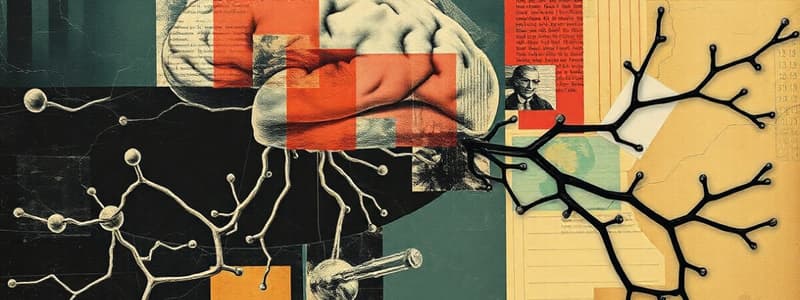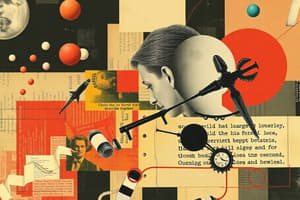Podcast
Questions and Answers
What is the primary effect of drugs that block the release of neurotransmitters at the synapse?
What is the primary effect of drugs that block the release of neurotransmitters at the synapse?
Anticholinesterase drugs work by prolonging the effect of acetylcholine in the synapse.
Anticholinesterase drugs work by prolonging the effect of acetylcholine in the synapse.
True (A)
What is the primary mechanism by which selective serotonin reuptake inhibitors (SSRIs) increase the effect of serotonin in the synapse?
What is the primary mechanism by which selective serotonin reuptake inhibitors (SSRIs) increase the effect of serotonin in the synapse?
SSRIs block the reuptake of serotonin, leading to a greater concentration of serotonin in the synaptic cleft, where it can bind to receptors and exert its effects.
Drugs that prolong the effect of neurotransmitters in the synapse by preventing their breakdown are called ______ inhibitors.
Drugs that prolong the effect of neurotransmitters in the synapse by preventing their breakdown are called ______ inhibitors.
Signup and view all the answers
Match the following drugs with their respective mechanisms of action:
Match the following drugs with their respective mechanisms of action:
Signup and view all the answers
Which of the following is NOT a way in which drugs can affect synaptic transmission?
Which of the following is NOT a way in which drugs can affect synaptic transmission?
Signup and view all the answers
Drugs that block receptor binding can prevent the effects of neurotransmitters even if they reach the synapse.
Drugs that block receptor binding can prevent the effects of neurotransmitters even if they reach the synapse.
Signup and view all the answers
Give an example of a drug that works by inhibiting the breakdown of a neurotransmitter.
Give an example of a drug that works by inhibiting the breakdown of a neurotransmitter.
Signup and view all the answers
Which ion is found in higher concentration outside the cell?
Which ion is found in higher concentration outside the cell?
Signup and view all the answers
Calcium ions (Ca²⁺) are found in greater concentration inside the cell than outside.
Calcium ions (Ca²⁺) are found in greater concentration inside the cell than outside.
Signup and view all the answers
What ion tends to move into the cell when there is a higher concentration outside?
What ion tends to move into the cell when there is a higher concentration outside?
Signup and view all the answers
More ____________ is present inside the cell compared to outside.
More ____________ is present inside the cell compared to outside.
Signup and view all the answers
Match the following ions with their concentration gradient status relative to the cell:
Match the following ions with their concentration gradient status relative to the cell:
Signup and view all the answers
Which lobe of the brain is primarily responsible for language comprehension?
Which lobe of the brain is primarily responsible for language comprehension?
Signup and view all the answers
The Basal Ganglia consists of the cerebellum and the brainstem.
The Basal Ganglia consists of the cerebellum and the brainstem.
Signup and view all the answers
What is the primary function of the Somatic Nervous System?
What is the primary function of the Somatic Nervous System?
Signup and view all the answers
The __________ lobe processes sensory information and is involved in language processing for reading and writing.
The __________ lobe processes sensory information and is involved in language processing for reading and writing.
Signup and view all the answers
Match the following brain structures with their primary functions:
Match the following brain structures with their primary functions:
Signup and view all the answers
What is the role of the sympathetic nervous system?
What is the role of the sympathetic nervous system?
Signup and view all the answers
The parasympathetic nervous system is responsible for voluntary control of body functions.
The parasympathetic nervous system is responsible for voluntary control of body functions.
Signup and view all the answers
What type of control does the autonomic nervous system provide?
What type of control does the autonomic nervous system provide?
Signup and view all the answers
The sympathetic nervous system prepares the body for ______, ______, or freeze.
The sympathetic nervous system prepares the body for ______, ______, or freeze.
Signup and view all the answers
Which characteristic does the parasympathetic nervous system exhibit?
Which characteristic does the parasympathetic nervous system exhibit?
Signup and view all the answers
The ______ nervous system conducts sensorimotor signals.
The ______ nervous system conducts sensorimotor signals.
Signup and view all the answers
Match the nervous system components to their primary function:
Match the nervous system components to their primary function:
Signup and view all the answers
The autonomic nervous system is responsible for the conscious control of voluntary movements.
The autonomic nervous system is responsible for the conscious control of voluntary movements.
Signup and view all the answers
What is one of the significant impacts of disruption to the CNS protective mechanisms?
What is one of the significant impacts of disruption to the CNS protective mechanisms?
Signup and view all the answers
The Foramen Magnum is the point where the spinal cord exits the skull.
The Foramen Magnum is the point where the spinal cord exits the skull.
Signup and view all the answers
What are the two primary functions of the meningeal layers?
What are the two primary functions of the meningeal layers?
Signup and view all the answers
The ______ fossa is a region of the internal skull.
The ______ fossa is a region of the internal skull.
Signup and view all the answers
Match the following terms to their corresponding descriptions:
Match the following terms to their corresponding descriptions:
Signup and view all the answers
Which layer of the meningeal structure is closest to the brain?
Which layer of the meningeal structure is closest to the brain?
Signup and view all the answers
Name one condition that can arise from disruption to CNS protective mechanisms.
Name one condition that can arise from disruption to CNS protective mechanisms.
Signup and view all the answers
The meningeal layers only serve a protective function.
The meningeal layers only serve a protective function.
Signup and view all the answers
What is the primary effect of lateral inhibition?
What is the primary effect of lateral inhibition?
Signup and view all the answers
Parkinson's disease results from an increase in signals at D1 receptors.
Parkinson's disease results from an increase in signals at D1 receptors.
Signup and view all the answers
What is the nature of Multiple Sclerosis?
What is the nature of Multiple Sclerosis?
Signup and view all the answers
Parkinson's Disease involves the degeneration of __________ in __________.
Parkinson's Disease involves the degeneration of __________ in __________.
Signup and view all the answers
Match the following symptoms with their associated disease:
Match the following symptoms with their associated disease:
Signup and view all the answers
What characterizes the relapsing-remitting pattern of Multiple Sclerosis?
What characterizes the relapsing-remitting pattern of Multiple Sclerosis?
Signup and view all the answers
Multiple Sclerosis attacks lead to gradual axonal destruction over time.
Multiple Sclerosis attacks lead to gradual axonal destruction over time.
Signup and view all the answers
What happens during the remission phase of Multiple Sclerosis?
What happens during the remission phase of Multiple Sclerosis?
Signup and view all the answers
Flashcards
Somatic Nervous System
Somatic Nervous System
Innervates skeletal muscle and conducts body sensation and movement signals.
Frontal Lobe
Frontal Lobe
Responsible for higher cognition, motor movement initiation, and expressive language.
Parietal Lobe
Parietal Lobe
Processes sensory information, attention, body schema, and language for reading and writing.
Basal Ganglia
Basal Ganglia
Signup and view all the flashcards
Cerebellum
Cerebellum
Signup and view all the flashcards
Peripheral Nervous System
Peripheral Nervous System
Signup and view all the flashcards
Autonomic Nervous System
Autonomic Nervous System
Signup and view all the flashcards
Sympathetic Nervous System
Sympathetic Nervous System
Signup and view all the flashcards
Parasympathetic Nervous System
Parasympathetic Nervous System
Signup and view all the flashcards
Fight or Flight Response
Fight or Flight Response
Signup and view all the flashcards
Rest and Digest
Rest and Digest
Signup and view all the flashcards
Energy Saving Mechanism
Energy Saving Mechanism
Signup and view all the flashcards
CNS Protective Mechanisms
CNS Protective Mechanisms
Signup and view all the flashcards
Cranial Fossa
Cranial Fossa
Signup and view all the flashcards
Foramen Magnum
Foramen Magnum
Signup and view all the flashcards
Meningeal Layers
Meningeal Layers
Signup and view all the flashcards
Cerebrospinal Fluid (CSF)
Cerebrospinal Fluid (CSF)
Signup and view all the flashcards
Hematomas
Hematomas
Signup and view all the flashcards
Hydrocephalus
Hydrocephalus
Signup and view all the flashcards
Meningitis
Meningitis
Signup and view all the flashcards
Ion concentration gradient
Ion concentration gradient
Signup and view all the flashcards
Sodium (Na+) concentration
Sodium (Na+) concentration
Signup and view all the flashcards
Calcium (Ca2+) concentration
Calcium (Ca2+) concentration
Signup and view all the flashcards
Ion movement
Ion movement
Signup and view all the flashcards
Cell membrane permeability
Cell membrane permeability
Signup and view all the flashcards
Parallel signals
Parallel signals
Signup and view all the flashcards
Lateral Inhibition
Lateral Inhibition
Signup and view all the flashcards
Action Potentials
Action Potentials
Signup and view all the flashcards
Inhibitory Interneurons
Inhibitory Interneurons
Signup and view all the flashcards
Parkinson’s Disease
Parkinson’s Disease
Signup and view all the flashcards
Multiple Sclerosis
Multiple Sclerosis
Signup and view all the flashcards
D1 Receptors
D1 Receptors
Signup and view all the flashcards
Motor System
Motor System
Signup and view all the flashcards
Blocking effect
Blocking effect
Signup and view all the flashcards
Prolonging effect
Prolonging effect
Signup and view all the flashcards
Anticholinesterase drugs
Anticholinesterase drugs
Signup and view all the flashcards
Selective Serotonin Reuptake Inhibitors (SSRIs)
Selective Serotonin Reuptake Inhibitors (SSRIs)
Signup and view all the flashcards
Neurotransmitter binding
Neurotransmitter binding
Signup and view all the flashcards
Neurotransmitter reuptake
Neurotransmitter reuptake
Signup and view all the flashcards
Post-synaptic neuron
Post-synaptic neuron
Signup and view all the flashcards
Synapse
Synapse
Signup and view all the flashcards
Study Notes
Overview of the Nervous System
- The brain has two sides, similar but not mirror images.
- Sensory and motor functions are represented in both hemispheres.
- Communication and cognition processes differ.
Organizational Views of the Nervous System
- Anatomical: Grouping by structures (cells, lobes, nerves, ganglia)
- Functional: Grouping by function (motor control, language, sensory)
Central vs. Peripheral Nervous System
- Central Nervous System (CNS): Brain, brainstem, and spinal cord, protected by bony coverings (skull & vertebrae)
- Brain inside the cranium (skull)
- Spinal cord inside the spinal canal, created by the vertebral column.
- Gray matter in brain = makes up the outer surface (cortex) and several deep structures (nuclei).
- Gray matter in spinal cord sits on the inside.
- Peripheral Nervous System (PNS): Nerves extending outward from the brainstem and spinal cord.
- Includes 12 cranial nerves and 31 pairs of spinal nerves.
- Not protected by tissue or body structure.
Brain Lobes
- Frontal Lobe: Higher-level cognition, initiates motor movements, and basic expressive language.
- Parietal Lobe: Processes sensory information, involved in attention, body schema, visual processing, and language processing for reading and writing.
- Temporal Lobe: Language comprehension, regions for memory, visual processing, and olfactory (smell) processing.
- Occipital Lobe: Receives visual signals.
Other Structures
- Basal Ganglia: Formed of deep nuclei and extensively connected to motor and sensory systems.
- Thalamus: Acts as a sensory relay station, highly interconnected with brainstem, cerebellum, and cortex.
- Cerebellum: Involved in coordination of muscles, body equilibrium, and connects to language and cognitive systems. Located posterior to the brainstem.
- Brainstem: Composed of midbrain, pons, and medulla. Connects the brain to the spinal cord.
- Includes the midbrain, pons, and medulla oblongata.
Surface Landmarks
- Sagittal sulcus: Separates right and left hemispheres.
- Central sulcus: Separates frontal and parietal lobes.
- Pre-central gyrus: Anterior to central sulcus.
- Post-central gyrus: Posterior to central sulcus.
- Sylvian fissure (lateral sulcus): Separates temporal lobe from frontal and parietal lobes.
- Insula: Cortex deep in the Sylvian fissure.
Medial Surfaces
- Cingulate gyrus: Part of the limbic system, involved in emotions and memory.
- Corpus callosum: Massive white matter tract connecting the right and left hemispheres.
- Calcarine sulcus: Landmark in occipital lobe.
- Thalamus: Sensory relay station.
- Hypothalamus: Part of the limbic system, involved in regulating body systems.
Ventricular System
- Ventricles: Internal spaces filled with Cerebrospinal Fluid (CSF)
- Lateral Ventricles
- Third Ventricle
- Fourth Ventricle
- CSF is produced by specialized ependymal cells, called choroid plexus.
- CSF functions: Protection, buoyancy, waste removal, circulation of nutrients.
Disruptions to the Ventricular and Meningeal Systems
- Hematomas: Pooling of blood.
- Epidural Hematoma: Between skull and dura mater.
- Subdural Hematoma: Between dura mater and arachnoid mater.
- Normal Pressure Hydrocephalus: Ventricles appear large and dilated.
- Low Pressure Hydrocephalus: Leaks in meninges, causing reduced buoyancy.
- Communicating Hydrocephalus: Problem with arachnoid granuloma reabsorption.
- Noncommunicating Hydrocephalus: Blockage of CSF flow.
Neuronal Communication
- Neurons communicate within cells (via electrical signals - Action Potentials) and between cells (primarily chemically via neurotransmitters).
- EPSP (Excitatory Postsynaptic Potential): Opens Na+ channels, causing depolarization.
- IPSP (Inhibitory Postsynaptic Potential): Opens K+ channels, causing hyperpolarization.
- Summation of EPSPs and IPSPs determines whether an action potential is created or not.
- Temporal Summation: Summation over time.
- Spatial Summation: Summation of many inputs at the same time.
Action Potential
- The rapid sequence of changes in membrane potential during the passage of a nerve impulse.
- Involves opening and closing of sodium and potassium channels.
- Refractory periods: Absolute and Relative.
Neurotransmitters
- Chemical messengers that transmit signals between neurons.
- Types: Amino acids, Amines, Peptides.
Neurotransmitters Relevant to Cognition/Communication
- Gamma-aminobutyric acid (GABA): Inhibitory effects.
- Glutamate: Excitatory effects.
- Acetylcholine (ACh): Excitatory effects.
- Dopamine: Motor system.
- Epinephrine: Reward behaviors.
- Norepinephrine: Attention and vigilance
- Serotonin: Sleep-wake cycles, mood
Diseases Involving Synaptic Transmission
- Parkinson's Disease: Degeneration of dopamine-producing neurons, resulting in decreased signals, leading to movement problems.
- Multiple Sclerosis: Autoimmune disease attacking myelin, leading to slowed action potentials.
- Myasthenia Gravis: Autoimmune disease attacking ACh receptors, causing muscle weakness.
Studying That Suits You
Use AI to generate personalized quizzes and flashcards to suit your learning preferences.
Related Documents
Description
This quiz explores the effects of drugs on neurotransmitter release and synaptic transmission. It covers various drug mechanisms, including SSRIs and anticholinesterase drugs, as well as the roles of different ions in synaptic activity. Test your understanding of how these substances interact at the synapse.




